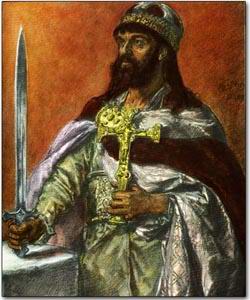Doubravka of Bohemia was a Bohemian princess of the Přemyslid dynasty and by marriage Duchess of the Polans.
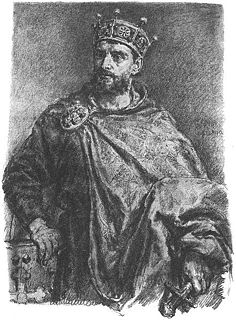
Mieszko II Lambert was King of Poland from 1025–1031, and Duke from 1032 until his death.

The Congress of Gniezno was an amical meeting between the Polish Duke Bolesław I the Brave and Emperor Otto III, which took place at Gniezno on 11 March 1000. Scholars disagree over the details of the decisions made at the convention, especially whether the ruler of Poland was pledged the king's crown or not.

The Duchy of Greater Poland was a historical Polish province established in 1138 according to the Testament of Bolesław III Krzywousty. It existed during the period of fragmentation of Poland until 1320, centered at Poznań, Gniezno and Kalisz in the Greater Poland region.

Przemysł I, a member of the Piast dynasty, was Duke of Greater Poland from 1239 until his death, from 1241 with his brother Bolesław the Pious as co-ruler. He was able to re-acquire large parts of Greater Poland, ruling as Duke of Poznań and Gniezno from 1247 and, upon several inheritance conflicts with his brother, as Duke of Poznań and Kalisz from 1249, sole Duke of Greater Poland from 1250, and Duke of Poznań from 1253 until his death.
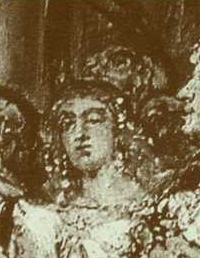
Bezprym was a Duke of Poland from 1031–1032.
Leszek of Masovia was a Polish prince from the Piast dynasty, the Duke of Masovia from 1173 until his death. He was the only son of Bolesław IV the Curly, Duke of Masovia and High Prince of Polan, who survived father. After his father death he inherited Masovia. At the beginning, Leszek ruled under the guardianship of his uncle Casimir II the Just. He was a man of poor health. For a short time he supported his other uncle, Mieszko III the Old, but later decided to reconciled with Kazimierz II, who after Leszek's death inherited his duchy.

Helena of Znojmo, was a Bohemian princess, a member of the Přemyslid dynasty. She was the daughter of Duke Conrad II of Znojmo and his Serbian wife Maria of Rascia. Helena was probably named after her maternal aunt, Queen Helena of Hungary, wife of King Béla II.
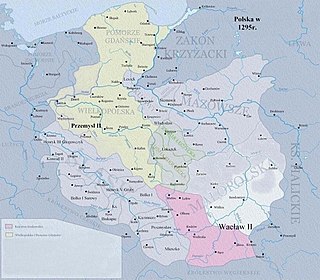
Seniorate Province, also known as the Senioral Province, Duchy of Kraków, Duchy of Cracow, Principality of Cracow, Principality of Kraków, was the superior among the five provinces established in 1138 according to the Testament of Bolesław III Wrymouth. It existed during the period of fragmentation of Poland until 1320, centered at Kraków in Lesser Poland. The Seniorate Province was supposed to be ruled by the rotating head of the royal Piast dynasty, a principality that he held as overlord of the other Polish dukes.
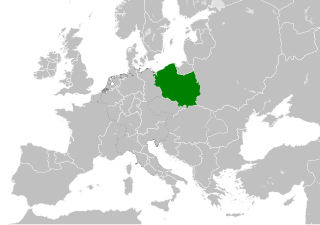
Civitas Schinesghe is the first recorded name related to Poland as a political entity first attested in 991/2. The original deed is missing, but is mentioned in an 11th-century papal regesta called Dagome iudex. It states that the Piast duke Mieszko I of Poland had given the guidance of unam civitatem in integro, que vocatur Schinesghe over to the Holy See.

Casimir II the Just was a Lesser Polish Duke of Wiślica from 1166–1173, and of Sandomierz after 1173. He became ruler over the Polish Seniorate Province at Kraków and thereby High Duke of Poland in 1177; a position he held until his death, though interrupted once by his elder brother and predecessor Mieszko III the Old. In 1186 Casimir also inherited the Duchy of Masovia from his nephew Leszek, becoming the progenitor of the Masovian branch of the royal Piast dynasty, and great-grandfather of the later Polish king Władysław I the Elbow-high. The honorific title "the Just" was not contemporary and only appeared in the 16th century.
Świętopełk Mieszkowic, was a Polish prince member of the House of Piast.
Otto Bolesławowic (1000–1033) was a Polish prince and member of the House of Piast.
Dobroniega Ludgarda of Poland was a Polish princess, Margravine of Lusatia by marriage to Theodoric I, Margrave of Lusatia.

Agnes of Poland, was a Polish princess member of the House of Piast and by marriage Princess of Pereyaslavl and Volynia and Grand Princess of Kiev since 1168.

The period of rule by the Piast dynasty between the 10th and 14th centuries is the first major stage of the history of the Polish nation. The dynasty was founded by a series of dukes listed by the chronicler Gallus Anonymous in the early 12th century: Siemowit, Lestek and Siemomysł. It was Mieszko I, the son of Siemomysł, who is now considered the proper founder of the Polish state at about 960 AD. The ruling house then remained in power in the Polish lands until 1370. Mieszko converted to Christianity of the Western Latin Rite in an event known as the Baptism of Poland in 966, which established a major cultural boundary in Europe based on religion. He also completed a unification of the West Slavic tribal lands that was fundamental to the existence of the new country of Poland.
